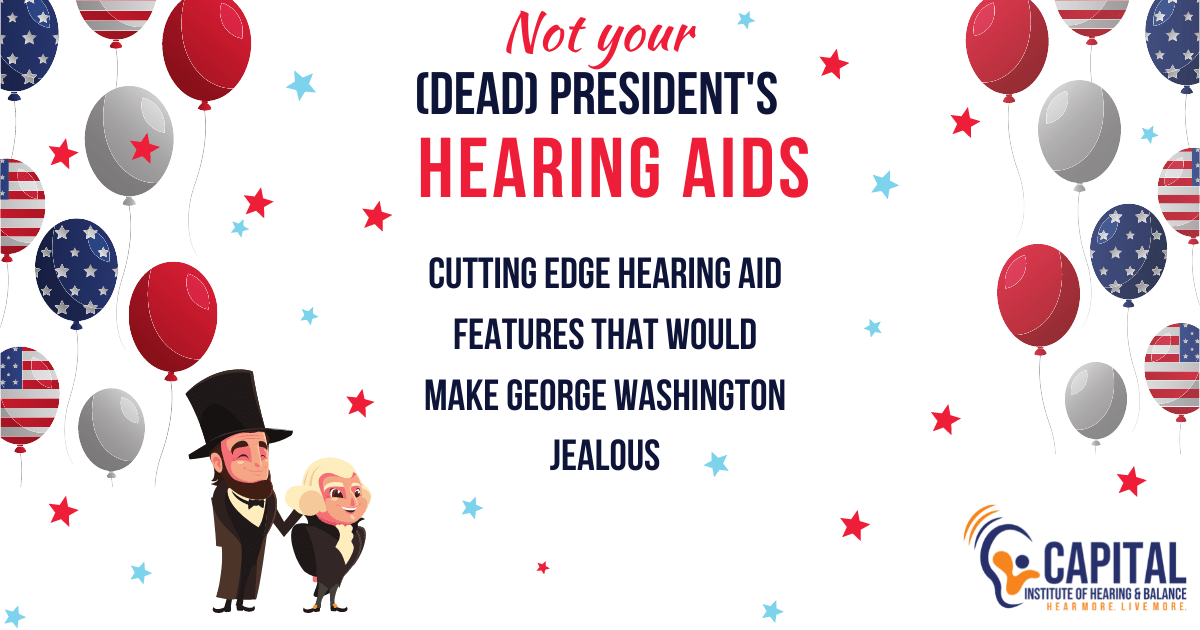
Jealous George
Well, maybe not George Washington. Let’s move forward a little bit on the timeline of presidential hearing loss. Two-score minus one year ago, in 1983, President Reagan became the first sitting president to use hearing aids. In the forty years since, hearing aids have evolved as dramatically as tech in other sectors. Let’s highlight a few of these cutting edge hearing aid features, shall we? Along the way, we’ll assign some awards for our favorite marvels of hearing technology.
Arguably the Most Important Cutting Edge Hearing Aid Feature: Signal Processing
Firstly, hearing aids haven’t been mere amplifiers for decades. Computer chips made their way into hearing aids in the 1980s (last century, as you Gen Zs like to point out), and today’s hearing aids digitally process sound. The hearing aid’s computer chip treats the signal differently based on its sound type (a few examples are quiet speech, speech in noise, music, noise only). This means the hearing aid can more fully meet the various goals of the user: understand speech, enjoy music, feel comfortable in a noisy situation, etc.
New hearing aids also take advantage of artificial intelligence to more accurately predict user preferences in various listening environments. The most advanced hearing aids have started utilizing deep neural networks, a more state-of-art machine learning approach.
Tinnitus Relief
Given that most people with tinnitus also have hearing loss, this feature is especially handy. Many hearing aids have the ability to generate sounds that reduce the prominence of tinnitus.
Water Resistance
It used to be that moisture was a death knell for a hearing aid. Thankfully, water resistant hearing aids are common now. Fully waterproof hearing aids are also available.
 The Hearing Aid Feature That Matters: Size
The Hearing Aid Feature That Matters: Size
In contrast to houses, brownies and bank accounts, most consumers prefer their hearing aids to be small. Behind-the-ear (BTE) hearing aid size has dropped plenty over the past few decades. This is due largely to the advancement of digital hardware and other hearing aid components. Compact hearing aid parts mean smaller hearing aids. Little hearing aids are less obtrusive and less noticeable.
Behind-the-ear hearing aids aren’t the only styles of aids striving to be smaller. Tinier components paved the way for a relatively new custom hearing aid style (formed specifically to a user’s ear canal) to hit the market. Invisible-in-the-ear (IIC) hearing aids sit deep in the ear canal and are usually undetectable by a casual observer. They are less fully featured than behind-the-ear hearing aids but have their own advantages.
Design
The physical appearance of hearing aids hasn’t just changed in terms of dimensions. Hearing aid shape and color have undergone makeovers that would make Chip and Joanna Gaines jealous. While custom hearing aids (those with components completely housed in the ear canal and/or concha bowl of the ear canal) have generally kept to a palette of skin tones, BTE hearing aids also offer a range of colors that typically match contemporary trends. This allows hearing aids, much like glasses, to serve as accessories and expressions of personality and fashion.
The Absolutely Essential Cutting Edge Hearing Aid Feature: Bluetooth Connectivity
One of the most useful features to crop up within the past decade is the ability to stream sound both to and from mobile devices. This allows hearing aids to double as extremely sophisticated wireless headphones. It means that the phone can be used hands free and any sound streamed from the phone through the hearing aids is optimized for that individual’s hearing abilities.
Smartphone Apps
Bluetooth didn’t crash the hearing aid party alone. Its hot date, the smartphone app, has vastly expanded the functionality of hearing aids. Consider this partial list of app features that can currently be accessed through the apps of various hearing aid manufacturers. They allow users to:
- Control the hearing aids (changing not just volume and programs, but also the high, mid and low frequencies and from which direction the hearing aid picks up sound)
- View hearing aid battery life
- Track hearing aid location
- Set geotags to automatically switch the hearing aids into a preferred listening program (like, say, settings optimized for your favorite restaurant go into effect when you walk in the door)
- Have an alert sent to family or caregivers when a fall is detected
- Use the phone as a hearing aid microphone (very helpful when conversing one-on-one with someone in a noisy setting)
- Translate foreign languages in the app
- Transcribe spoken word (basically a live closed-captioning feature)
- Request wireless/remote programming changes by the audiologist
Wireless Connectivity to Accessories
Hearing aid manufacturers produce a range of wireless accessories to help with particular situations. Some of these accessories include:
- Hearing aid remote controls
- Television streamers, which allow the individual with hearing loss to listen at a comfortable volume, independent of the sound from the television speaker.
- Remote microphones. These are the best tools for understanding speech at a distance (such as in classrooms and lecture halls) or in noisy situations.
Goodbye, Tiny Toxic Button Batteries: Rechargeable Hearing Aids
Wrangling tiny hearing aid batteries is quickly becoming nothing more than an unhappy memory for longtime hearing aid wearers. Can I get a “hallelujah” from all you hearing aid users with large fingers, reduced feeling in your digits, low vision and arthritis? Rechargeable hearing aids are simple to dock, easy to use and reduce disposable battery waste.
Not Actually A Cutting Edge Hearing Aid Feature: Tiered Service Delivery Models
Confession: this isn’t an inherent hearing aid trait, but provides a lot of flexibility for hearing aid wearers. Traditionally, hearing aids and hearing aid services have all been bundled into one price, which does not work for all wearers. What if you need more services than are included in the package price? What if you transferred care from another practice and don’t need the whole package? Is your schedule too tight for traditional appointment times? Do you want extra access to your audiologist and the peace of mind afforded by an after-hours phone number? The tiered model that has been so helpful in other industries has finally been adopted by hearing care.
If you want to experience for yourself the upgrades that have been made in hearing aid features and technology, schedule an appointment with your audiologist.



 The Hearing Aid Feature That Matters: Size
The Hearing Aid Feature That Matters: Size